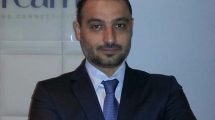 It’s not a secret that the industry is growing much faster than our traditional markets. Supplies in capacity have and are still increasing rapidly offering almost the same applications. Those limited applications are the main challenge to the growth of our industry. Because of the oversupply, limited growth and price competition some colleagues went to the extreme and claim that we have already entered the commodity era of the satellite industry. In my opinion this is not the whole story, I’m optimistic and the picture is bright.
It’s not a secret that the industry is growing much faster than our traditional markets. Supplies in capacity have and are still increasing rapidly offering almost the same applications. Those limited applications are the main challenge to the growth of our industry. Because of the oversupply, limited growth and price competition some colleagues went to the extreme and claim that we have already entered the commodity era of the satellite industry. In my opinion this is not the whole story, I’m optimistic and the picture is bright.
I said this before and I’m saying it again, I think this is very short term. In the mid-term, we will witness major changes in the industry. Many new applications will come on-board but ironically the game changer is not us, the game changer is the market. In my opinion to achieve that, we need to continue sending simple and consistent messages relevant to each market segments.
SkyStream believes that there are unlimited opportunities and the top management goal is to share this belief with the rest of the team. Antoine de Saint-Exupery said: “If you want to build a ship, don’t drum up men to gather wood. Divide the work and give orders. Instead teach them to yearn for the vast and endless sea.” The sea is vast, our industry has so many avenues and that will open the doors for us in many aspects.
Satellite can offer unlimited solutions for many challenges faced by different markets, but we need to find them first. We started communicating with the market since 2010 by sending simple consistent messages such as satellite is an affordable (price performance) IP pipe that offers features like mobility and extended reach. Those messages were effective and the market’s positive response exceeded all expectations.
Middle East and Africa
The ME and Africa is not an exception to the rest of the world. Here the satellite industry is facing bigger challenges to grow. To understand those challenges, we need to have a deeper look at the market. We have always had an opportunistic approach in the region. Our approach was a result of the situations on the ground such political or economical instabilities to provide temporarily solutions till a permanent one takes over. Some examples for this is fibre connectivity in Africa, Iraq and Afghanistan, and there is nothing wrong with this approach except it’s always temporary and not permanent.
Today we are facing challenges in certain markets since we haven’t seen growth in demand. I believe something can be done about this if we isolate the challenges for each market. The general structure of the ME and African market can be segmented into two: potential markets but unstable due to security, economical or political sanctions; while the other market segment is potential but heavily regulated.
In the first market segment we will continue using the same old opportunistic approach. Due to their challenges, everything has to be short-term, and reactive. However there is much more we can do in the other market segment, if we manage to convince the regulators to open up the market. Regulators are very conservative and sceptical about satellite. This can be for many reasons. Security is always first, while other regulators still believe in monopoly.
To access those markets, there should be an effort from both sides through two way dialogue addressing the regulator’s concerns. The regulators too have to recognise the importance of satellite communications. Satellite is another brick in any country’s infrastructure. If this happens market size will grow significantly, and the impact would be tremendous for our growth.
New Applications
Every industry is improved by the challenges of its end users, and the reaction of the industry to those challenges. SkyStream learned and evolved a lot from its customers’ challenges and we owe our success to those clients. We are committed to continue listening to our clients and understand their challenges, that’s in the DNA of the company. SkyStream believes in the uniqueness of every market segment. Each segment has different challenges and the first thing we do in this process is to generate a specific theme for each market.
Let’s take the military as an example, the simple purpose of a military operation is to destroy the enemy’s ability to use its troops. In the past it was based on inaccurate mass destruction. The price for such war was high in terms of number of casualties and financial obligations. Today, however, the war is different. It’s about precise, accurate, pinpointed operations to destroy the enemy’s capabilities. In order to do so, militaries need certain elements, and one of these is continuously available, reliable and secure communications. This is the basis for building our terminals and our solutions.
The military’s general theme of requirement is the need for quick auto-deploy reliable solutions that are scalable. They require the possibility to work with military as well as commercial satellites. Communications need to be secure and terminals need to operate in multiple bands. Mobility is another requirement, and requires a solution that will mitigate jamming. Then we use all of the above information to customise a solution that fits the customer’s specific requirements.
The same methodology is applicable in law enforcement, on mega-yachts and in Oil and Gas environments.
Proven Record
We have customised many networks for military and law enforcement after the rise of security concerns in the Middle East and the fear from terror. Protecting borders is a concern and satellite is one of the few solutions that can cover this. Today we are working with purpose built cars. These are surveillance cars which are 100% undercover. They have 360-degree high definition cameras and two operators that sit inside and edit the information. There are also interception systems and this is already in use for governments, and is connected directly to headquarters via satellite.
Moreover the cars are equipped with local storage to support 24/7 recording, with a lot of layers of redundancy. There are also applications that can do number plate detection and face recognition. It serves the purpose of being the frontline for some operations. This example was something that the market came and asked us to design. The customer came and explained the challenges, we listened to their needs and their expectations, then built the solution around it.
Looking at mega-yachts we examined the need of the end user first. We realised they don’t use the yachts throughout the year, so the solution was not about connectivity to the yacht, it was about connectivity to the end-user, whether they need it in the Yacht or somewhere else. The delivered network supported connectivity to the yacht, along with the offices, resorts and camps that the user would tend to visit. In essence connectivity was always established, wherever the end user went, without the need to pay for small bandwidth and every bit of it. The solution was about customer needs and experience. While maritime happened to be one of the applications that serviced the client, it is terrestrial backhauling and many applications within the same bandwidth that the customer is paying for.
Moving Forward
SkyStream strongly believes in after sales services and understands the importance of reliable and highly available connectivity. Our state of the art 24×7 NOC along with our highly qualified onsite engineers will continue to be our backbone to support our clients.
We are starting strategic partnerships in the region with licensed telecom operators and are investing with them to develop certain markets mainly in GCC.
Last but not least, SkyStream is moving ahead to build its own flat panel Manpacks and communications on the move antennas.













Add Comment